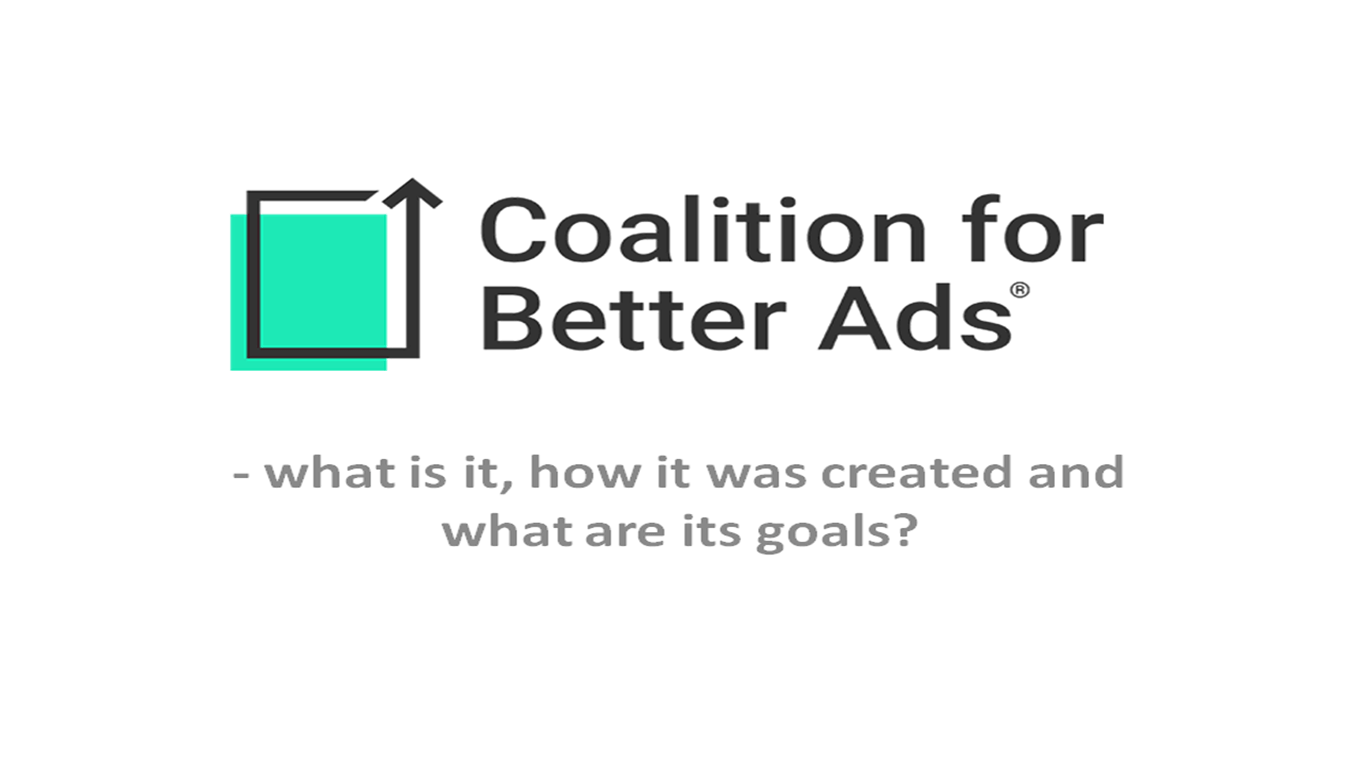Coalition for Better Ads - what is it, how it was created and what are its goals?

source: own elaboration
At the Dmexco digital advertising fair, which was held in Cologne, Germany on September 14-15, 2016, Google and 16 other entities related to the online marketing industry announced the formation of a coalition to create global standards for online advertising. Coalition for Better Ads, as this coalition group was called, supposed to be a direct response to the increasingly frequent ads blocking and at the same time a recipe for the impatience of Internet users caused by too intrusive, poorly created marketing communication on the web.
Members
The founders of the coalition were entities such as: American Association of Advertising Agencies (4A’s), Association of National Advertisers (ANA), BVDW Germany, Digital Content Next, DMA, European Publishers Council, Google, GroupM, IAB, IAB Europe, IAB Tech Lab, Network Advertising Initiative (NAI), News Media Alliance, Procter & Gamble, Unilever, The Washington Post and World Federation of Advertisers (WFA). Soo in addition to international organizations, they also included advertising service providers and companies, i.e., advertisers themselves. Of course, during the 6 years of its existence, the coalition has significantly increased the number of its members. As you can find out on its website - https://www.betterads.org/ - it consists of 34 members, including giants of the advertising industry such as Facebook and Google. The coalition also cooperates with over eighty other entities operating mainly at the national level, including from our country - iab Poland.
Mission
The coalition was founded to create global standards for internet advertising. Even on the website announcing the formation of the coalition, members announced that their criteria for measuring the quality of advertising will be based on consumer research. They shell help determine which advertisements Internet users want and which they would rather avoid. The technology created by IAB Tech Lab, which allows to evaluate ads based on a number of criteria (such as page loading time, number of tracking pixels and type of creation), will also be applied in the development of standards. Coalition members wanted to initiate the application of these standards, inter alia, by imposing strict criteria on themselves and their partners regarding advertisements published on related sites. As we can read on the official website of the coalition:
How does the coalition work?
Coalition members form four committees where they can share their knowledge and experience: Standards and Research Committee, Communications and Awareness Committee, Accountability Committee and Technology Committee. Each of them has its own tasks - and so the first one collects the opinions of Internet users and other data and on this basis creates standards that should be met in order to provide the consumer with the best possible advertising experience. According to the coalition, entities related to online advertising should comply with them for the benefit of the public, but also because of other benefits that such action will bring. These include, above all, improving the brand image in the consumers eyes, less ad blocking and a greater number (and quality) of potential partners.
The task of the Communications and Awareness Committee is to build awareness of consumers and companies about the Better Ads Standards and other tools developed by the coalition to increase the comfort of digital advertising recipients.
Whereas the Responsibility Committee initiated a program of certification for companies to compliance of the Better Ads Standards and supervises its operation. It allows advertisers and other advertising market players to clearly communicate to their partners that they are operating to the highest standards set by the coalition.
As you can guess, the task of the Technology Committee is to ensure that Better Ads Standards can be properly implemented by web browsers and other technologies.
The Research
The Coalition wants to improve the quality of online advertising, bearing in mind primarily consumers, and thus the standards it sets shell be based on their preferences. It is because of their dissatisfaction caused by, among other things, the fact that advertisements delayed access or disrupted viewing of relevant content, that advertising-blocking tools were created and gained in importance.
The coalition was created precisely to improve the consumer experience related to online advertising, and because of that, it also constantly conducts research to determine what types of advertising, consumers prefer the least. For this purpose, it uses mapped real user experiences when advertisements appear on their screens while reading or watching high-quality content on the Internet. They most often form four control groups - in one ads are not displayed at all, while in the remaining 3, different messages are shown. Then, a survey is carried out to find out which marketing content annoys Internet users the most and why.
From the results of a survey made with thousands of consumers, a „stack ranking” is created that includes dozens of different advertising experiences, from better to worse. The same model can be used for advertising messages displayed on websites on computers and mobile devices, during video and in applications. These consumer rankings are then combined with additional data on how increased consumer annoyance caused by advertising correlates with a greater likelihood of using ad-blockers. Only on the basis of such combined data on consumer preferences the Coalition identify advertisements that don’t meet the minimum acceptance threshold - Better Ads Standards for specific digital environments.
Does it work?
More ads that comply with the Better Ads Standards result in fewer people using ad-blockers. According to Neal Thurman, Coalition director, In North America and Europe, the installation rate of ad-blockers in Chrome on desktops has dropped 60% from the time when the Coalition was created at the end of 2016 until the first quarter of 2020. The decline in ad blockers downloads is also confirmed by independent studies - an online survey by AudienceProject with over 14,000 participants from the US, UK, Germany, Denmark, Sweden, Norway and Finland showed that fewer respondents use ad blockers in 2020 than four years earlier.

